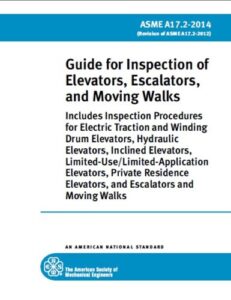ASME A17.2-2014 Guide for Inspection of Elevators, Escalators, and Moving Walks
ASME A17.2-2014 Guide for Inspection of Elevators, Escalators, and Moving Walks
ASME A17.2-2014 Guide for Inspection of Elevators, Escalators, and Moving Walks intended to assist qualified inspectors performing routine inspections and witnessing periodic and acceptance inspections and tests. It is not intended to serve as a basis for government regulations. This Guide does not contain information on handling discrepancies noted during an inspection and test. The authority having jurisdiction in their legislation adopting the Code is responsible for addressing this subject. The acceptance inspection and testing procedures apply only to the extent that they conform to the latest edition of the A17.1/B44 Code. The routine and periodic inspection and testing procedures apply only to the extent that they conform to the applicable Code requirements that were in effect at the time of installation or alteration. The inspection and testing procedures do not take into account local regulations that may differ.
You can also Read ASME A17.4-2015 Guide for Emergency Personnel
ASME A17.2-2014 Guide for Inspection of Elevators, Escalators, and Moving Walks
- Foreword
![ASME A17.2-2014]()
- Committee Roster
- Preface
- Summary of Changes
- Introduction
- Elevator — Inside of Car
- Elevator — Machine Room
- The Elevator — Top of Car.
- Elevator — Outside Hoistway
- Elevator — Pit.
- The Elevator — Firefighters’ Service
- Escalator — External
- Escalator — Internal
- Moving Walk — External
- Moving Walk — Internal
- Elevator — Machine-Room-Less (MRL)
This Guide covers recommended inspection and testing procedures for electric and hydraulic elevators, escalators, and moving walks required to conform to the Safety Code for Elevators and Escalators, A17.1–1955 and later editions and The Safety Code for Existing Elevators and Escalators, A17.3. This Guide also addresses some requirements from editions of A17.1 prior to 1955.It is recognized that inspectors will not be able to accomplish all the inspection procedures specified in this Guide, during each inspection. Qualified inspectors have the knowledge and experience to recognize potential deficiencies and to focus the inspection in those areas.


Comments are closed.